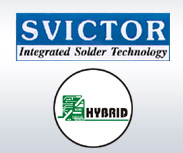Soldering with no-clean flux is a viable alternative for eliminating
the laborious post solder cleaning using costly and polluting
CFC solvent cleaning.
To eliminate cleaning, the flux and soldering
process must:
a) Bind effectively to make sound solder joints
b) Leave minimal amount of residue after soldering
c) Have left over residue which is translucent, aesthetically
acceptable and non-tacky that will not interfere in any in-circuit testing, automated
pin testing or bed-of-nails testing.
d) Have left over residue that will not react with the circuit
or components and will stay inert and not be influenced
by changes in temperature, humidity or fluctuations in voltage.
e) Be economic and practically feasible.
We offer specially formulated no-clean fluxes
that meet the above conditions, and are suitable for a variety
of applications.

No-Clean Fluxes are low solid (less than 5%)
fluxes, specially developed for SMDs and mixed technology
soldering. They are completely non-halide, show outstanding
solderability on all types of board including SMDs, give excellent
wetting on surface mounted components, and leave no visible
flux residue after soldering. Often no further cleaning is
required, but if very high ionic cleanliness is needed, the
residue can be removed by solvent or saponification cleaning.
These fluxes are J-STD-004 compliant.
No-clean fluxes with solid content less than 3% are also available
for use in foam flux operations as well as application by
dipping, brushing or spraying.
Those with solid content less than 2.2% have been developed
to meet industry's need for high speed automation and high
reliability. The small amount of residue is non-corrosive
(meets IPC and J STD requirements) and tack free ( meets Bell
Core specification).
We also have a low solid-2%- flux, that is halide free, no-resin,
no rosin flux, for soldering through hole, mixed technology,
surface mount and solar panel assemblies. It can be applied
by spray, dip and foam equipment. It meets ANSI / IPC SF-818
Assembly Class 3, SIR requirements.
| FLUX NUMBER |
810 |
810 LRF |
910 |
830 |
827-SPS |
819 Low VOC |
820 VOC free |
| TYPE |
No-Clean |
No-Clean |
No-Clean |
No-Clean |
No-Clean |
No-Clean |
No-Clean |
FLUX CLASSIFICATION
J-STD-004 |
ORL0 |
ORL0 |
ORL0 |
ORL0 |
ORL0 |
ORL0 |
ORL0 |
| PHYSICAL STATE |
Clear Liquid |
Clear Liquid |
Clear Liquid |
Clear Liquid |
Clear Liquid |
Clear Liquid |
Clear Liquid |
| SPECIFIC GRAVITY |
0.795@25°C |
0.81@25°C |
0.794@25°C |
0.81@25°C |
0.816@25°C |
0.940@25°C |
1.005@25°C |
| SOLIDS CONTENT |
5% |
2% |
3.5% |
2% |
2% |
2% |
2% |
| COLOUR |
Straw |
Water Clear |
Straw |
Pale Straw |
Water Clear |
Water Clear |
Water Clear |
| ACID NUMBER |
20 |
18 |
18 |
18 |
18 |
18 |
18 |
| FLASH POINT(TCC) |
16°C |
22°C |
25°C |
25°C |
21.5°C |
65°C |
None |
| SILVER CHROMATE TEST |
Passes |
Passes |
Passes |
Passes |
Passes |
Passes |
Passes |
| COPPER MIRROR CORROSION TEST |
Passes |
Passes |
Passes |
Passes |
Passes |
Passes |
Passes |
| RESIDUE |
Very small amount of residue, usually not noticed. Residue is non-conductive and tack free and does not interfere in accurate pin testing |
| RESIDUE REMOVAL |
Often no cleaning is required. High degree of ionic cleanliness and high SIR can be achieved if the small amount of flux residue is removed by rinsing in cleaning solvent |
| RECOMMENDED THINNER |
811T |
811T-LRF |
910 Dissolvent |
830 T |
827T |
819T |
811T |
FOR TECHNICAL BULLITIN / MSDS CLICK HERE







